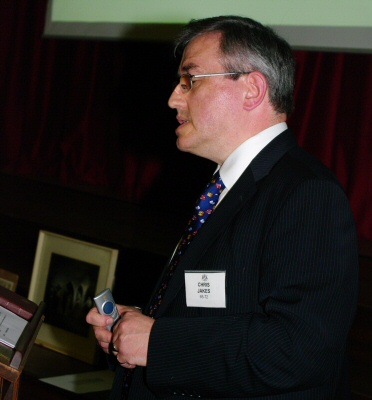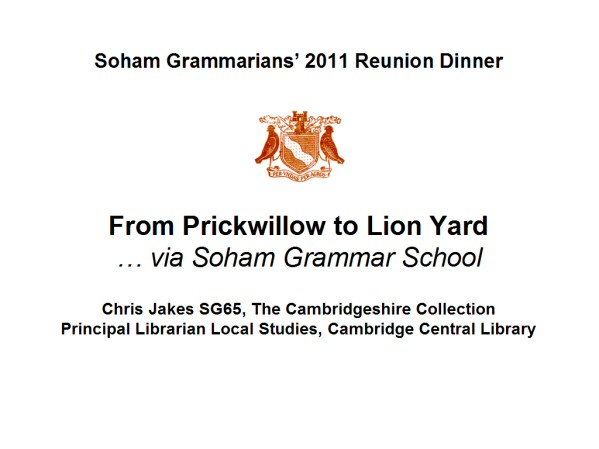
This page contains some large images so please allow time
for it to download if you have a slow connection
The podium is nearly as tall as me. Up until now I have been enjoying this evening - you may all be saying that in ten minutes! A special hello to the class of 65, nice to see you all again. |
|
| I grew up in Prickwillow, and for
those of you who have never been there - or wanted to
go there - it is a village six miles north of Soham
and four miles east of Ely. It is unusual for a variety of reasons for it is situated in the Fen itself, not above it - nor on an island like Haddenham, Ely and Littleport, and not on the Fen edge like Soham, Wicken and Isleham. It is, as you would expect, somewhat flat … although we do claim two “hills” (in the Fens we use that term loosely); Shippea Hill, which on a good day rises three metres above sea level and Putney Hill on the Isleham Road which soars magnificently … to just above the nought contour. The land around it is now below sea level and continues to get lower as the peat shrinks. The important thing, however, is that in a fen landscape these are places where you can keep your feet dry all year round and the names suggest they have been occupied since at least Saxon times – and in the case of Shippea Hill we now know much earlier than that. |
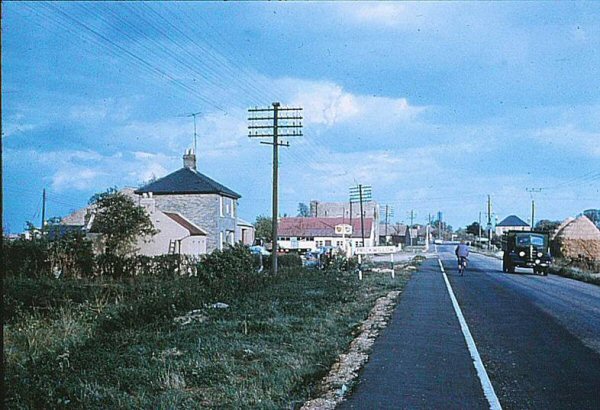 Prickwillow, Ely Road |
As a youngster growing up in Prickwillow – or Prickwilla as we all called it at the time – I knew none of that.
However … if you are lucky enough to live in a village with a name like that, the question “why?” is never far from your lips. You have some explaining to do.
Why is the village called that?
Why do people smirk and laugh when you say where you are from? (I learnt that one fairly quickly!)
I lived in Kingdon Avenue, yet everyone
wanted to call it Kingdom Avenue – who was Kingdon?
We had an old river bank, but no river near it and the Main
Street through the village was much higher than the land and
houses on either side of it. Why?
So I grew up with an enquiring mind and an ever increasing interest in my surroundings.
| I went to Prickwillow School. That's not quite all of us, there were a few more than that. We rarely turned out a First Eleven - we might do a First Four if we were lucky. My interest in history and geography grew. Not, I have to say, my interest in sport. Although on occasion I would kick a ball about with these lads and try my best at rounders. I was encouraged to read by my parents and read everything we had in the house and often received books as presents or as Sunday School prizes. At primary school I borrowed from the school library, later helping to tidy the collection and to sort out new deliveries. I enjoyed the story telling sessions and to this day return every now and then to re-read Rosemary Sutcliff’s The Eagle of the Ninth or Tolkien’s The Hobbit. |
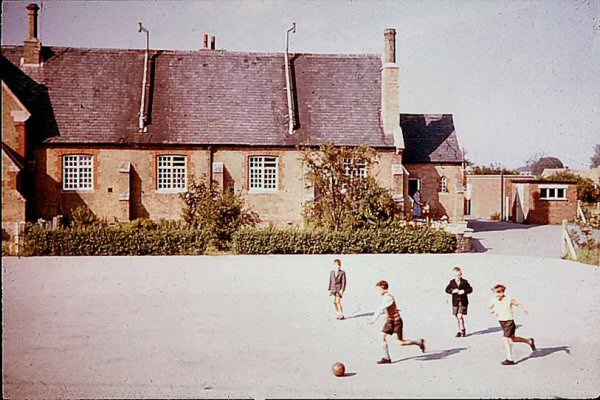 Prickwillow School |
I also started to read books about the history of Cambridgeshire and the Fens, rarely finding anything in them about Prickwillow, but I became more aware of local history – something other than the stories of countries and kings.
| And then as a youngster I had my
epiphany as far as local history was concerned. I was told that long ago a novel was written about Prickwillow. That seemed unlikely, very unlikely, but my grandparents assured me that this was true. It had been written in Prickwillow vicarage by a visiting clergyman and was said to be based on real people. They hadn’t got a copy but I could borrow one from the Public Library. I did and read Cheap Jack Zita for the first time. The author, Sabine Baring Gould wasn’t just any clergyman, he was famous! I recognised his name from the chapel hymn book, he had written Onward Christian Soldiers. Published in 1893 it is set at the time of the Littleport Riots and tells the story of two local farmers, rivals for the hand of Zita, a cheap jack or tinker’s daughter. The village tradition is that the characters are based on two local farmers whose story was told to Baring Gould by Claude Kingdon, our vicar, after whom Kingdon Avenue is named. |
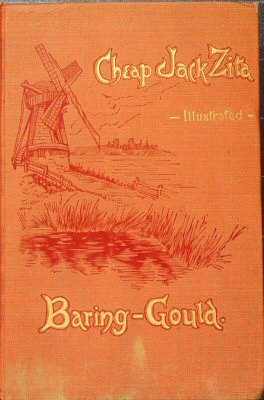 Cheap Jack Zita |
| Vincent Gudgeon will recognise this,
if nobody else ... I came to Soham Grammar School in 1965 and joined the other boys from Prickwillow who travelled in Howe’s taxi to Ely to catch the buses there. We caught the taxi at Howe’s Garage and only came to Soham by the shorter route through the fen when the taxi driver overslept. |
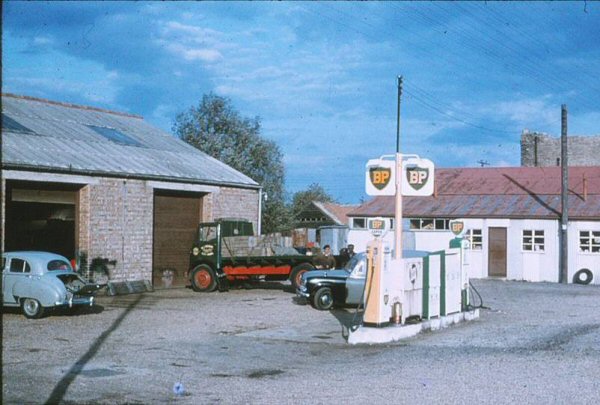 Prickwillow, Howe's Garage |
| This is 1935, it shows a
bus in Market Street, Ely, so it helps illustrate the
point. There were not many of us from Prickwillow; Graham Chambers (1961), John Harding (1962), Ivan Cox (1964) and me. Graham Chambers went on to manage casinos in far off and exotic places. John Harding was Head Boy in 1968, Ivan Cox Head Boy in 1970. I did neither of those things. But two Head Boys out of four is not a bad average and the advantage of growing up with them in the close, some might say claustrophobic, community of Prickwillow, outweighed the disadvantages. That is, we could probably play them up more than the rest of you. The year after me we had our annus mirabilis. Three more boys join us, Vincent Gudgeon (who would board), Kevin Neale and Paul Peachey. |
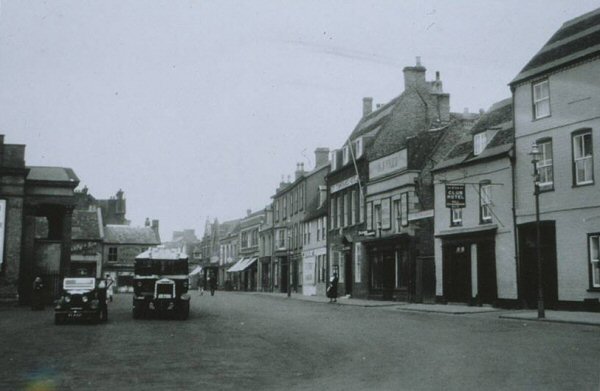 Ely Market Place 1935 |
After Oxford University John Harding became a journalist and reporter. He is now a freelance writer with his own website and a photo on Amazon. His first autobiographical novel What we did on our holiday published in 2000 and later dramatised for television, tells the story of his family coping with his father’s illness brought on by Parkinson’s Disease. His father, Fred, had also studied at Soham Grammar School and was the first person from Prickwillow to do so.
| In 2005 John had an article published
in The Sunday Times under the headline Escape
from Prickwillow; the by-line was "as a
youngster, novelist John Harding’s big ambition
was to leave his bleak Fenland village far behind
him". He is on the SG website. He mentions his time here briefly and his memories of Prickwillow in the 1950s and 1960s are much like mine. John did indeed get his wish, but I consider myself fortunate that my career has allowed me to remain in this county – and I imagine there are far worse places than Cambridge to work. |
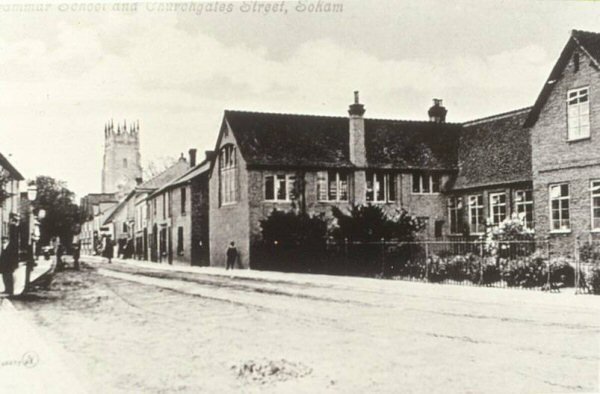 Soham Grammar School before the move to Beechurst |
| So I arrived in Soham excited, a
little apprehensive - and miffed because I had had to
go back into short trousers. I was not so grown up after all. I went and sat with the other new arrivals in 1A only to be told I should be in 1 Alpha. Start as you mean to carry on. I moved across to Mr Ellis’s class and took a desk next to Stuart Brooks. That first week older boys kept asking me if my name was Melton and if I was the younger brother of Melton senior? There was a Melton in 1A who didn’t look like me - I had (then) dark hair, glasses and big ears – and it would be unkind of me to suggest that I may have looked more like his brother than he did. |
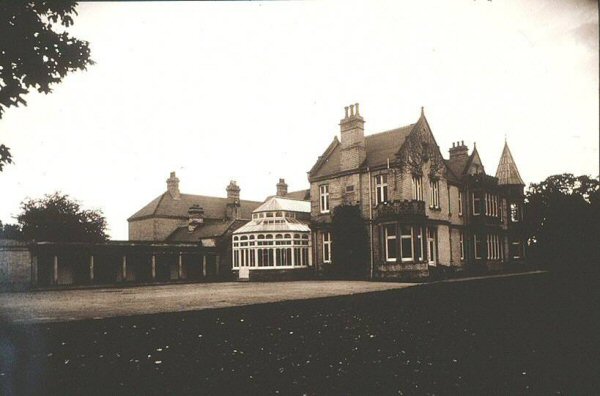 Soham Grammar School at Beechurst |
| In the first term we were given
Gideon New Testaments and I still have mine. In the front I wrote my name, my year and my school – Soham Grammer School I didn't learn a lot that first term – spelling was never one of my strengths and the red ink line through a word was a constant reminder of that. |
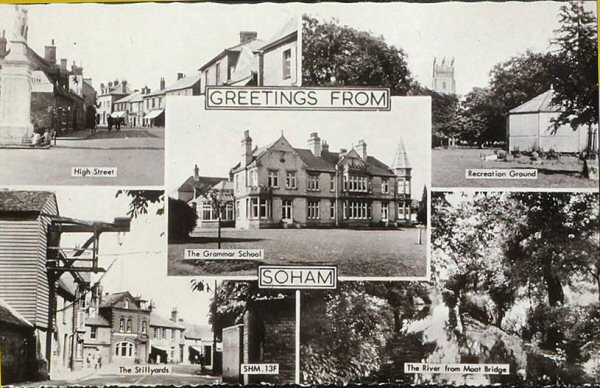 Soham, postcard composite of images including SGS |
| In one of the first lessons we had
with Peter Taylor (RAT)
he drew a map on the board showing Soham and all the
places around it. He went around the class asking us where we came from and pointing to it out on the board. My heart sank, there was no sign of Prickwillow. I would be the last and everyone would laugh. They did laugh, but I wasn’t the last. Stuart Brooks, sitting next to me, came from Soham Fen. Peter Taylor lived in Linton and was of course interested in its history. Later on he visited the Cambridgeshire Collection many times and gave us a number of very fine glass plate negatives of early views of the village. He was always interested in what we were doing and was pleased to reminisce about our time at school. He also never took my colleague very seriously, which was always good sport. |
 1576 Saxton map |
I muddled along academically, enjoying some subjects – history, geography, English, art, biology, R.I., tried my best with those that I did not always understand – Latin and Maths or was just plain useless at – Woodwork.
However there was one lesson that always filled me with dread and for years after I left Soham if ever I woke up in the morning with that sick feeling of panic that I had not done my homework, and I may have been 30 at the time – it was always French. Not just French, but Mr Hart’s French!
“Jakes” he said (and you can join in if you know the line) “You speak French like a native” – pause for effect - “A native of South Africa”.
Of course, the irritating thing is, he was absolutely right, I still do speak French like a native of South Africa.
Encounters with Dalai filled me with such dread that I was relieved when we had French with Mr Riley and as you all know, Tom Riley was no shrinking violet.
Needless to say I did not join the Scouts or the Chess Club!
| This is Ely Swimming Pool. Sport was not something that I excelled at. Returning to Soham still wet after a failed attempt at learning to swim in Newmarket Swimming Pool was not my idea of fun. Neither was cross-country running – I only ran so as not to miss the bus home. In football I certainly bruised more ankles than I scored goals and in cricket I always hoped no-one would hit the ball anywhere near me in case I had to try and catch it. So a dismal failure in a school that took great pride in its sporting prowess. |
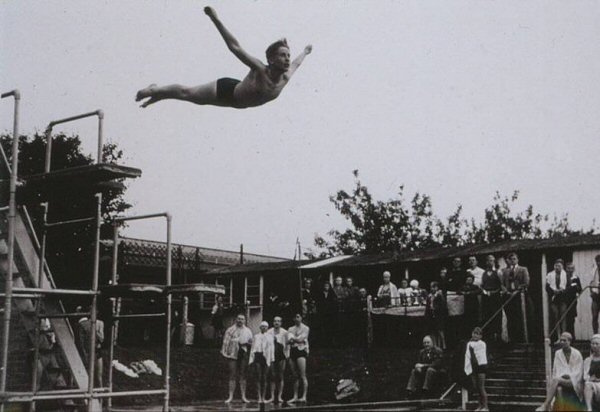 Ely Swimming Pool |
| This one is for Mr Scott. The most energetic thing I did which I enjoyed was joining the ACF [commanded by Mr Scott]. Wearing the uncomfortable uniform, resisting the temptation to race up and down the main stairs in our boots, hiding in the shrubbery in camouflage on parents’ days, going to the range at Barton Road and even being on parade was good fun. |
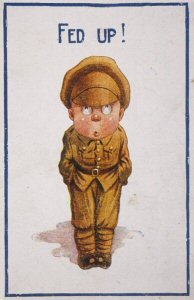 Fed Up |
| The only time I remember being hauled
up in front of the Headmaster was as the result of a
trip to Percy’s fish and chip shop in Ely [shown
here in earlier ownership]. On Thursday, market day, the shop was open when we got back to Ely and in between getting off the bus and catching our taxi back to Prickwillow the temptation to buy six pennyworth of chips was overwhelming. However, despite never having been told this, eating chips in school uniform wasn’t considered appropriate behaviour and the result was a somewhat hurt Headmaster admonishing a group of like-minded delinquent gourmands in his office. I never did find out which Prefect dropped us in it. |
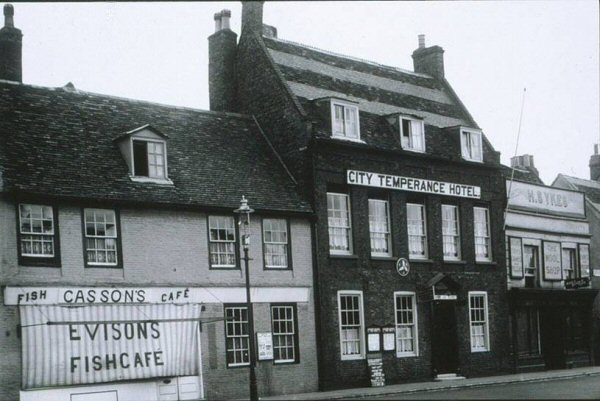 Ely Fish Shop |
At Soham I regularly used the school library and then helped John Abbott to run it. I can’t remember now if it was him or Mr Humphry, during a careers lesson, who actually suggested I might like to consider librarianship as a possible career. At that time I had only ever seen lady librarians, it hadn't occurred to me that there might be some males lurking about somewhere. The seed was sown and took root.
John Abbott, like Peter Taylor before him, nurtured and sustained my interest in history, made it interesting and encouraged me to find out more. In recent years as a District Councillor he was both a member and chairman of the County Advisory Group for Archives and Local Studies, always taking a keen interest in and always very supportive of the work of the County’s Archives and Local Studies Service. I enjoyed his company, his ready smile and his dry sense of humour.
I shall miss him.
| In 1972 when I left Soham Grammar
School there were two public library services
operating in Cambridgeshire – one for Cambridge
City and the other covering Cambridgeshire and the
Isle of Ely. I applied for jobs at both but reasoned that Cambridge probably had more to offer than the County service. Following an interview I was offered a trainee post in Cambridge and spent fifteen months working in every department in the Central Library, in every branch library and even on the mobile library. This is the building I started work in, it was at the back of the Guildhall, opposite the Corn Exchange. It had opened in the 1860s. This was our first Librarian, John Pink. Now if you look at that entrance it might be Jamie Oliver standing in the doorway. |
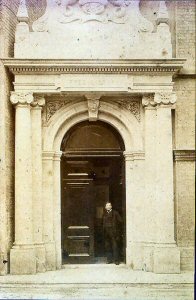 Cambridge Free Library |
| The Central Library in 1930. We made
you stand to read the newspapers in 1930. At the back
of the room in this photo you may make out 'Local
Collection' on the bookcases - that is where the
Cambridgeshire Collection was housed at that time. This was when I first came across the Cambridgeshire Collection and the librarian who was then responsible for it, Mike Petty, himself an old Soham Grammarian who had left the school before I arrived in 1965. I went off to Manchester Library School and was fortunate when I came out to be offered a post back at the then brand new Cambridge Central Library working in the Cambridgeshire Collection. My enthusiasm and interest in local history and local studies had been noted. I started working in the Collection in January 1976. At the end of 1996 Mike Petty fortunately decided to take very early retirement. |
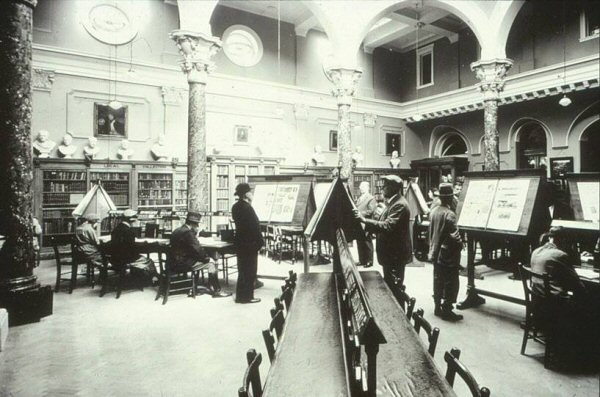 Central Library Interior 1930 |
I was appointed to manage Local Studies in Cambridgeshire Libraries becoming responsible for the Cambridgeshire Collection in Cambridge Library, the Huntingdonshire Collection in Huntingdon Library and the Fenland Collection in Wisbech Library, and also every local studies book in every library and the small team of librarians who deliver the service.
Over 20 years after I had left Soham Grammar School, I was very touched and somewhat surprised when Mr Armitage wrote a letter to the local newspaper saying that one of his old boys was to carry on the good work of another of his old boys.
| The Cambridgeshire Collection was founded in 1855 when the public library in Cambridge opened. | 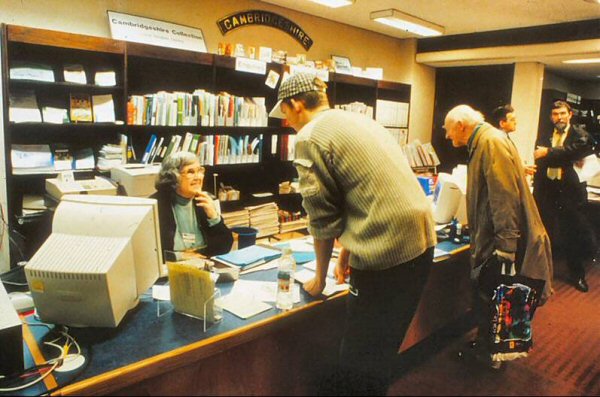 Cambridgeshire Collection enquiries counter [editor: CJ second from right] |
We have been collecting books about our county ever since and we collect printed and published material.
We have in our books catalogue over 80,000 entries and we are always looking for new material.
Only this week another novel has been published on the Littleport Riots - Starve and be Hanged by Peter Jeevar, so you can see which side of the fence that author sits.
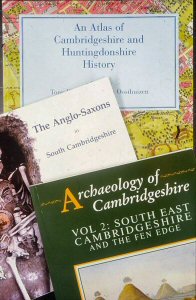 Books, Cambridge Library |
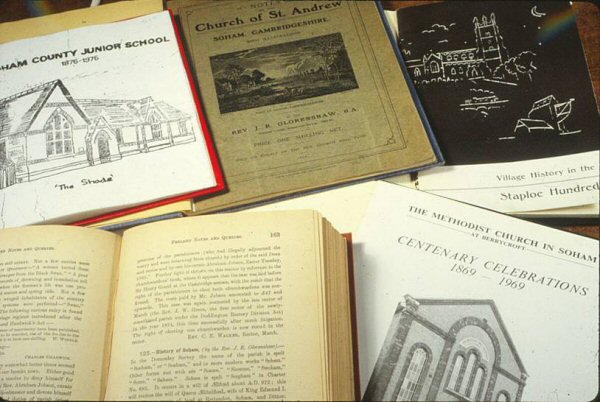 Books, Soham Library |
| The first published books we have are
from the sixteenth century. This is an extract from William Camden's Britannia, the Cambridgeshire portion, published in 1610. If you look halfway down it you' see how they described Fenmen "A Kinde of people according to the nature of the place where they dwell rude, uncivil, and envious to all others whom they call Upland-men; who stalking on high upon stilts, apply their minds to grazing, fishing and fowling." Camden's Britannia was still being published 200 years later. In the 1806 edition you have an early example of political correctness. That phrase has been altered to to "Fenmen, a set of people rough and uncultivated as the soil itself ..." hands up all Fenmen "envious of others whom they call Upland-men; devoted to the feeding of cattle, fishing and fowling, and usually marching about on a sort of stilts, like giants." Well we all do that at the weekend, don't we? |
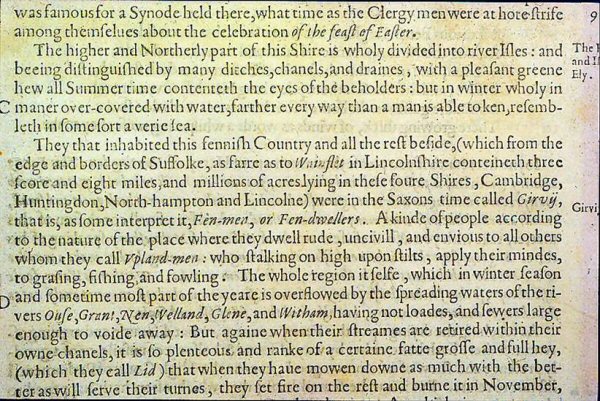 1610 Camden, Fen Dwellers |
| Here is an example of a county
directory. These were published between the 1840s and 1930s. They list every town and village in Cambridgeshire, with a list of the well-to-do, all the businessmen, who head teachers are, how much the vicar is being paid, and so on. |
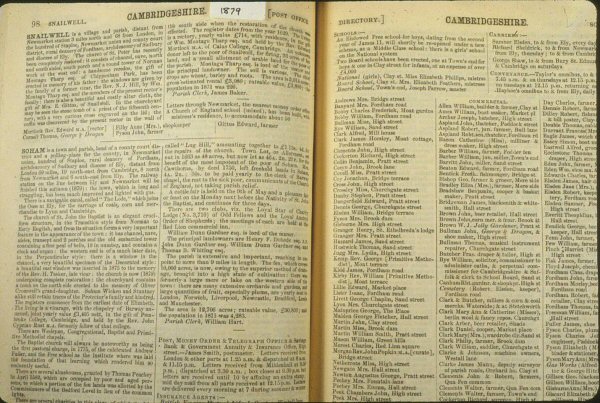 Kelly's Directory 1879 |
| We collect hundreds of magazines;
parish magazines, village magazines, school magazines
- we have quite a decent run of the Soham
Grammarian. And if you are interested - even at your ages - in the birds and the bees, then we can do these for you ... |
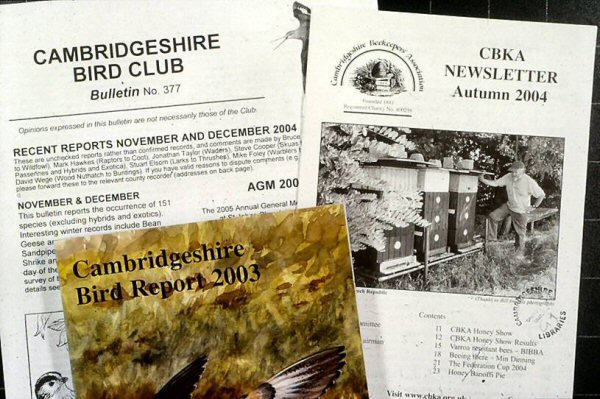 Magazines - Birds, Bees |
| That's a younger me. We have in the
centre of Cambridge Central Library created a bunker. You may remember that in 1994 Norwich Central Library went up in smoke. They lost their Local Collection If the Central Library burns down, for most of what the building contains we can go out and replace it - assuming we get the insurance money. If the Cambridgeshire Collection goes up in smoke I cannot go out and buy an original 1776 newspaper any more or replace the 4.5 million prints and negatives that we have. |
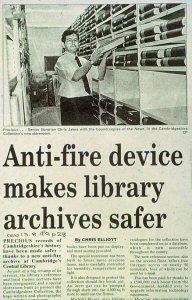 Archive Store, newspapers |
| I show this 1776 newspaper to
visiting Americans when they come round the
Collection. We were having a spot of bother with our
American cousins then. On 24th August, some six weeks after the event, the United States' Declaration of Independence was printed in full on the front page of the Cambridge paper. In the first column, halfway down, you may just make it out. What I love about local history is that it gives you an insight into national and international history. If you think of the Boston Tea Party - taxes on tea stirring up the Americans - in the same newspaper there is a report that Patrick McDonald, a tea smuggler, had been incarcerated in Cambridge Gaol. He had smashed his way through the roof and gone over the wall. The cheeky beggar had left a note for the gaoler, thanking him for his hospitality ... and said he'd probably be back in a fortnight. |
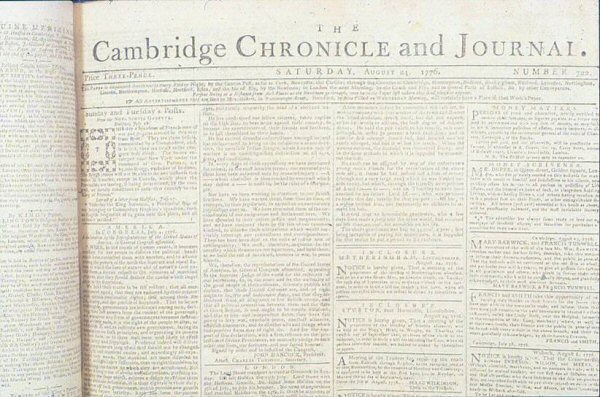 1776 Cambridgeshire Chronicle |
| June 1944, the report of the Soham
Railway Ammunition Train Explosion. The Censor was still at work so it doesn't actually tell you it's Soham. |
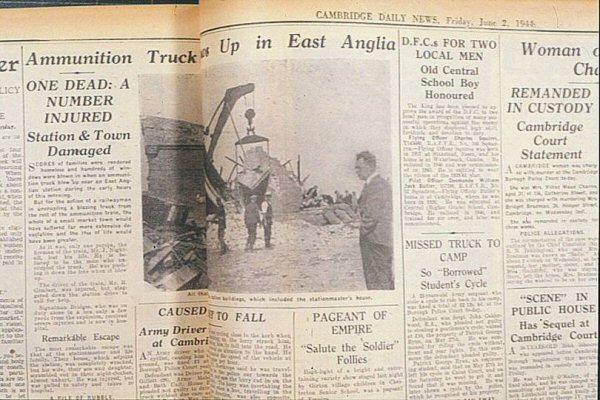 1944 Railway Explosion aftermath, newspaper 2 June 1944 |
| Since the early 1960s we have taken
press cuttings to do with all our villages and
different topics for the county. These are some 1961 articles about a very different Soham. |
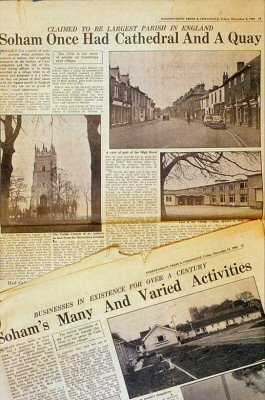 Cuttings - Soham articles |
| 1972, our parade through to the service at St Andrew's. | 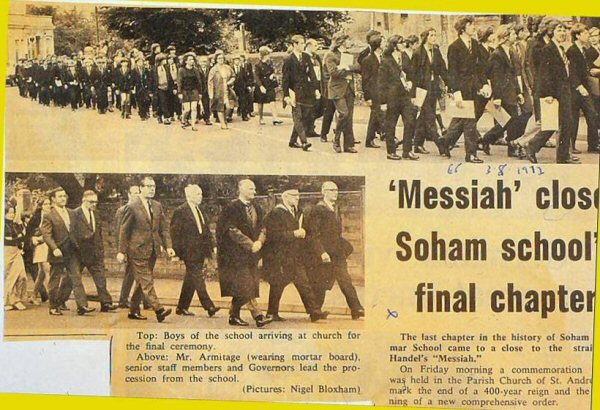 Cuttings, the end of Soham Grammar School |
| We have large collections of
ephemeral items - handbills, playbills, posters. This
is a public handbill sold at the public execution of
these three people for setting fire to stacks down
near Linton. You took your sandwiches, you took your bottle of beer, you sat on the Castle Mound, looked at the County Gaol - the scaffold was above the gate - and you spent all day. At noon, they'd haul the people out, execute them ... and you'd carry on eating your sandwiches. When I was talking at Linton I showed this slide and I said there is a Reader here being executed. If you look at the history of Linton, if ever there is a criminal activity, 8 times out of 10 it's a chap called Reader. I went on about the Readers and gave examples of their wrongdoing. Then somebody in the audience just happened to mention that he was called Reader and was from the same family. Now when I go out and do that sort of thing I always ask first - but then go ahead and do it anyway. |
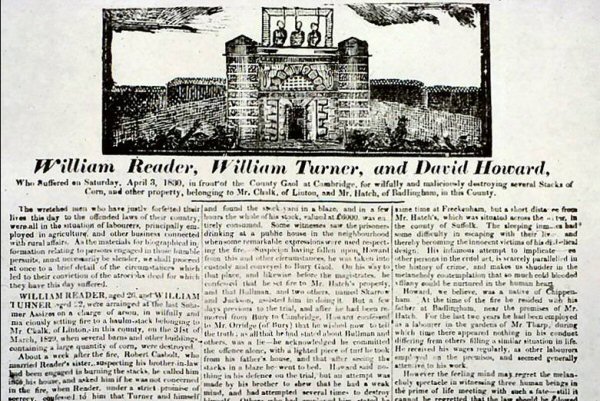 1830 Handbill, Reader, Turner & Howard execution |
| We have got maps of Cambridgeshire
from the 1570s. This is a detail of the plan of Soham from the 1640s. It shows the undrained fenland around Soham and the causeway linking Soham, Stuntney and Ely. North is on the right, just to confuse you. |
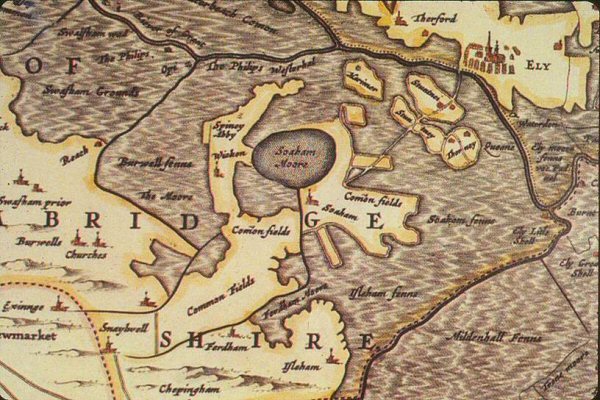 Map, 1648 Blaue, Soham |
| If you study local or national
history, always check your references. Never believe anything in print and if you publish anything - your family history, your business history, village history - never put 'accurate' in the title, because you'll regret it. This is part of a map published in 1751 by Emmanuel Bowen. He called it An Accurate Map of Cambridgeshire. If you all know where Cottenham is, look on this map just to the west of Cambridge you'll see where he has put Cottenham, but where Cottenham isn't. Coton [Cotton] is where it should be as are Dry Drayton, Girton and Madingley. But if you head west to find Cottenham you'll hit Wales before you do. |
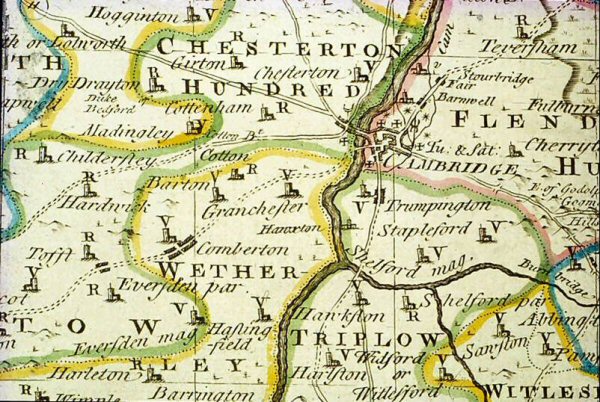 Map, 1751 Bowen, Cottenham |
| Large scale Ordnance Survey maps were
published for Cambridgeshire in the 1880s and again
in 1900. This is part of the Soham sheet published in
1901. In typical fashion I have chopped Beechurst off the bottom. |
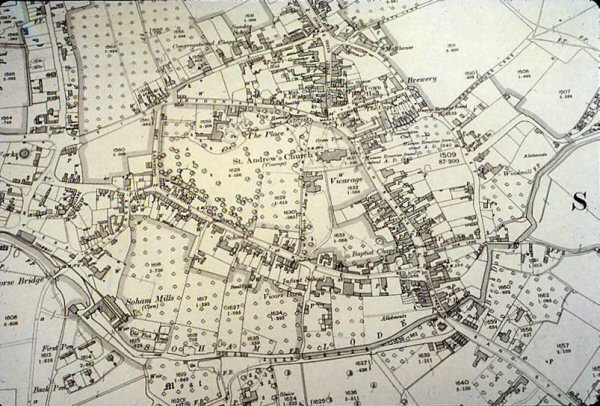 OS25" Soham Map 1901 |
| Family history - lots of people use
the Collection to study their family but be careful
what you wish for. A very nice lady in Australia wrote to us. She said her ancestor had been transported for burglary. She wanted a copy of the newspaper article and the court records. We looked at the newspapers and the court records - right chap, right date, wrong crime. He'd been transported for committing an unnatural act with a horse .... that begs the question, what's a natural act with a horse? That was one of my more neutral letters, accompanied by the copies. She probably gave up family history overnight. |
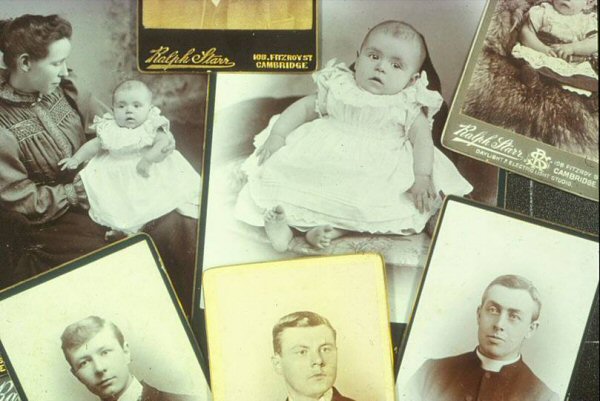 Family History |
| I mentioned that we have 4.5 million
images - postcards, photographs, engravings. We also
have lots of studio portraits, particularly from a couple of Cambridge studios - the
Palmer Clarke studio and the Ramsey & Muspratt
studio. If any of you ever went into the Ramsey & Muspratt studio to have your family photo taken, those negatives are now with us, tens of thousands of them. The nice thing about having the studio portrait archive is that you get every photo that was taken, not just the one that the sitter liked. |
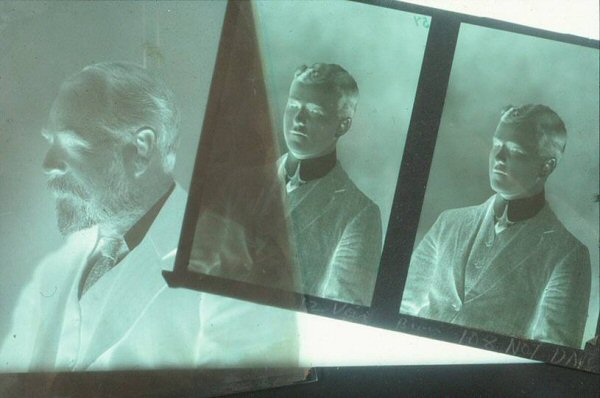 Glass negatives, Palmer Clarke archive |
| If you are a Bullman from Soham, this is a wedding photo from 1892 which was published 60 years later in the local newspaper. This sort of thing we have indexed. | 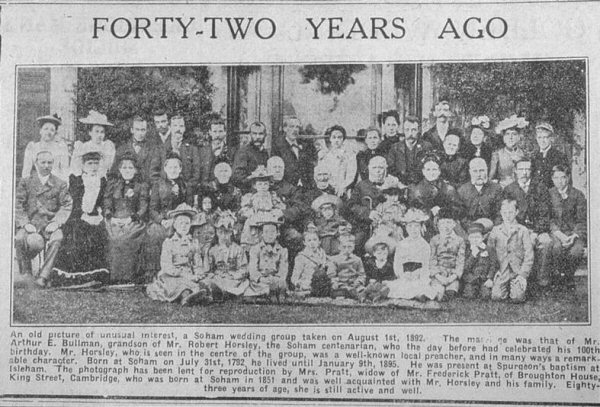 Bullman marriage 1892, newspaper article |
I'll stop there because I have gone on a bit.
The Cambridgeshire Collection is your collection, your stories, your family's stories, your community's story. It is a growing, living collection. If you can contribute to it, please do. If you publish your memoirs, as well as putting them on the SG website, think of depositing a copy with us. If you publish a business history, a history of a village, whatever, then we'd be interested in it. Although we have 4.5 million images, we have room for another 4.5 million.
Public Libraries, as you will be aware, are under threat across the UK and in Cambridgeshire because of national and local government budget cuts. A good public library, like a good school, lies at the heart of a community. It is a force for good, a place of learning, and a place of entertainment. A good public library, like a good school, can change people's lives.
They really do make a difference. Support them, use them, cherish them and if you can, contribute to them.
Thank you.
After the appreciative and well deserved applause from the audience, Frank Haslam invited Chris to show the rest of the images, knowing that there were some that would interest railway buffs present.
| Engraving of St Andrew's, Soham,
1797. Notice on the left, the chap sitting on the stocks, not in them. |
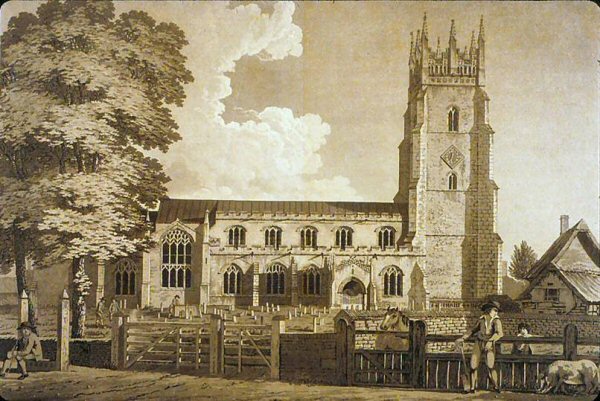 St Andrew's Church, Soham |
| Churchgate Street, Soham | 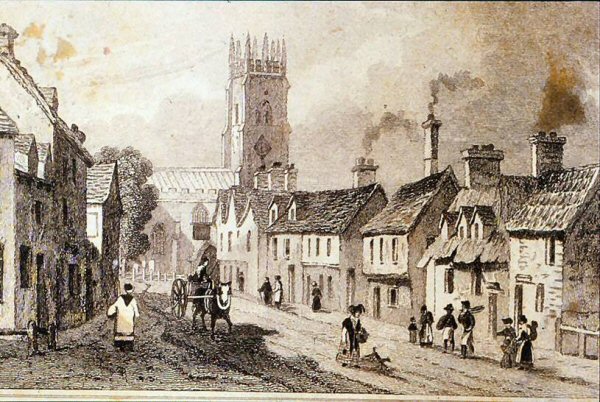 Soham, Churchgate Street, drawing |
| ... and a few years later. A Frith postcard from the 1950s. |
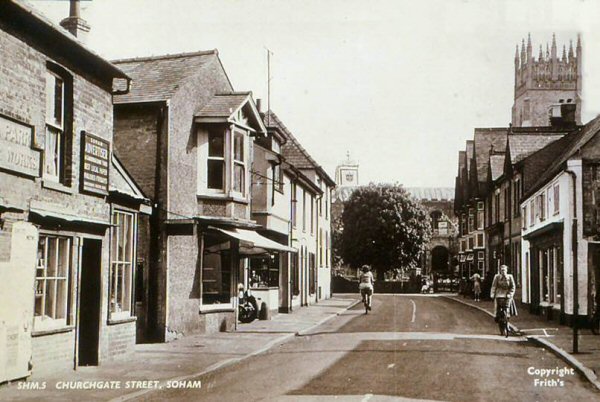 Soham, Churchgate Street, photo |
| A Soham church parade, 1910, by a Burwell photographer. | 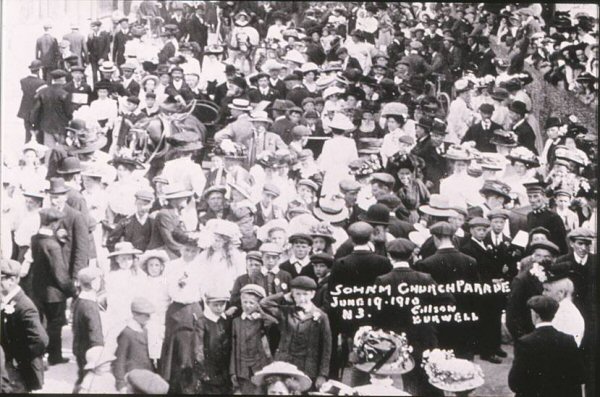 |
| Soham Station, before June 2 1944. | 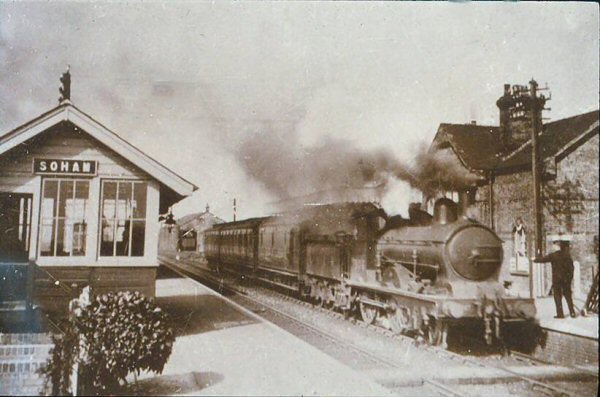 Soham Station, 1930s |
| We have a collection of photographs
taken by W Martin Lane, a photographer who was the
manager of Foster Brothers in Ely. [see also last year's talk on SGS at War for more on this disaster] |
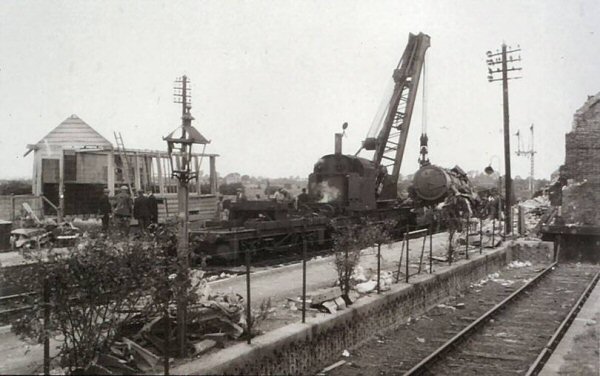 Soham Station, engine recovery after the bomb train explosion of June 2nd 1944 |
He took the following photos in 1944 and his negatives have come to the Cambridgeshire Collection.
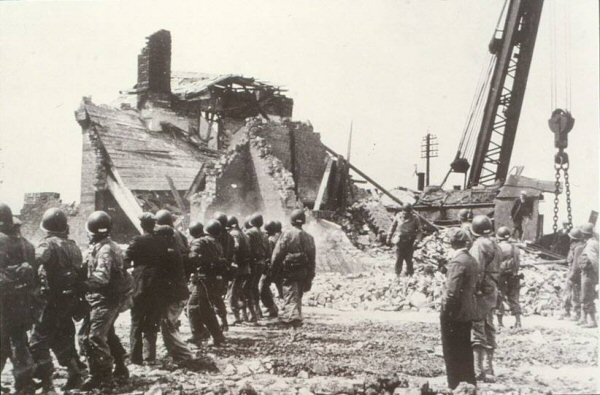 Soham Station, American servicemen assisting recovery operation |
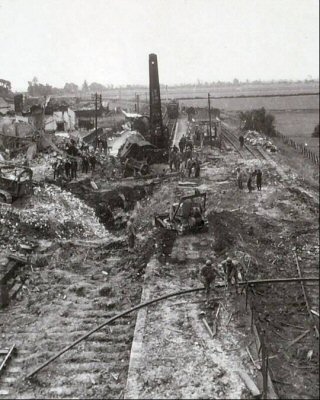 Soham Station, filling in the crater |
There is a new children's novel, The Deeping Secrets by Victor Watson [loosely] based on the story of the railway train explosion at Soham though it is moved to a fictional village called Deeping, which is actually Littleport!
| A couple of photos of damaged town houses in 1944. The one on the right was repaired and is still there, I think. | 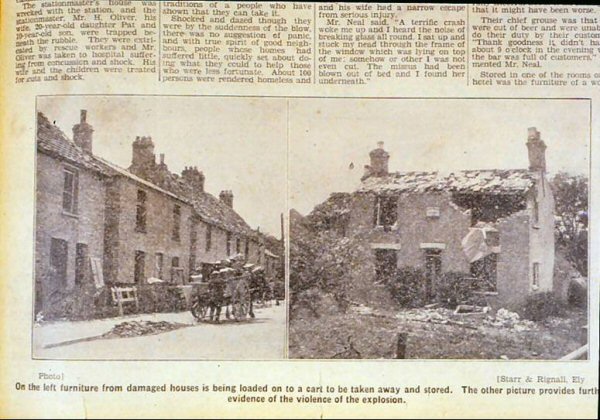 Soham, some of the property damage after the bomb train explosion of June 2nd 1944 |
| And if you want to read one of several accounts of the railway explosion at Soham, we have this. | 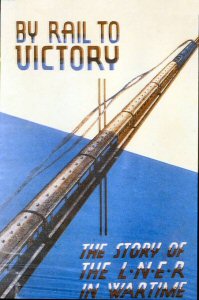 |
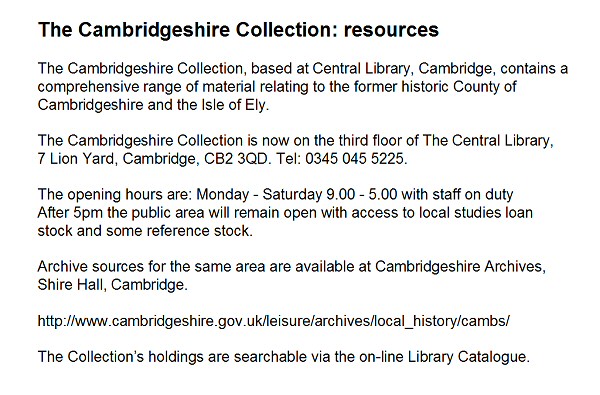
http://www.cambridgeshire.gov.uk/leisure/archives/local_history/cambs/
2011 Dinner Report
page created 15 Oct 2011, updated 17 Oct 11
Images: unless otherwise stated provided by Chris Jakes
Note: the links have been added by the editor and no
responsibility for the accuracy or otherwise of these can be
attributed to the editor or to Chris Jakes.
